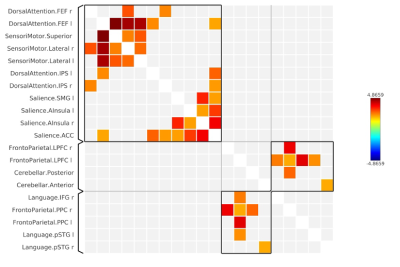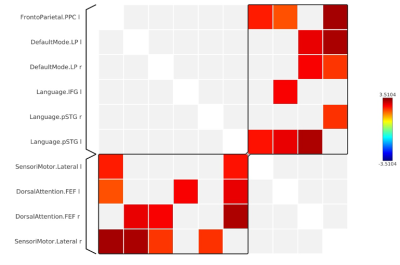2990
Understanding auditory cognition and its underlying acoustic characteristics1Department of NMR, All India Institute of Medical Sciences, Delhi, India
Synopsis
Auditory working memory is associated with sound pressure level for perception of information. However, its acoustic characteristics that represent information is not well understood. We used 1-back and 2-back auditory working memory tasks and acoustic characteristics (including pure tone assessment, audiometric threshold) to understand cognitive connectome with respect to frequency. This study explores the association of frequency characteristics underlying semantics necessary to understand auditory cognition.
Introduction
The underlying effect of noise on cognition is a complex process, which depends on the exposed sound pressure level (external parameter)1. Latent ability to perceive the information with the background noise may be different for each individual, though subjected to similar sound characteristics2. This study explores how acoustic characteristics of sound/noise are perceived in an audio cognitive model using functional MR imaging studies.Method
Auditory working memory tasks employing 1-back and 2-back were designed (single syllable words, each of duration of 1s) and were presented as auditory cues during functional imaging in healthy volunteers (n=103) in a 3T MR scanner (Ingenia 3T, M/s Philips). Subjects also underwent acoustic investigation (prior to fMRI study) of auditory brainstem response (ABR), pure tone assessment (PTA) from 125 Hz to 16kHz, and Distortion product otoacoustic emissions (DPOAE). To study the cognitive dependence of auditory cue of acoustics parameters, we estimated functional connectivity clusters for memory cognition and its interaction with acoustics characteristics using Multivariate Correlation (MVPA).The following model was hypothesized for delineating noise effect:Model 1: Memory= C + C: 125 Hz + C: 250 Hz +…+ C:16 kHz (dependency of cognitive process on cumulative characteristics of human auditory spectra at 125, 250, 500, 1000, 4000, 6000, 8000, 10000, 11200, 13000, 14000 and 16000 Hz)
where C is Functional connectivity matrix representation of the default networks and “:” represent model interaction with frequency variable characteristics assessed through PTA.
Result
Functional connectivity corresponding to 1-back memory cognition incorporating above model revealed a positive correlation of dorsal attention-frontal eye fields (FEF) (left/right (l/r)) with sensorimotor (superior-l and lateral) and dorsal attention-Intraparietal sulcus (IPS) (l/r), and salience-anterior cingulate cortex (ACC) with dorsal attention-IPS (l/r) (MVPA cluster statistic F=10.02; p<0.001). Lateral frontoparietal cortex (LPFC) (l/r) positively correlated with Language-inferior frontal gyrus (IFG)/superior temporal gyrus (STG) (MVPA cluster statistic F=9.24; p<0.001, Figure 1). On modelling the frequency interaction for 1-back memory cognition, Default mode-lateral parietal (LP), Language-IFG and Frontoparietal-posterior parietal cortex (PPC) positive correlated with Visual networks (MVPA cluster statistic F=5.23,4.98; p<0.05) associated with 500 Hz frequency characteristic interaction (Figure 2).In 2-back task, functional connectivity for memory cognition exhibited dorsal attention-IPS, Frontoparietal-PPC and default mode MPFC within and across cluster (F=4.24, 4.98; p<0.05, Figure 3). On modelling the frequency interaction for 2-back, memory cognition exhibited functional connectivity across dorsal attention-FEF(l/r) with Language-IFG, Frontoparietal-PPC and Default mode-LP cluster (F=5.15; p<0.05) having significant positive correlation associated with 125 Hz frequency characteristic (Figure 4).
Discussion
In both the n-back cognitive tasks, the functional connectivity coherence between dorsal attention and saliency network is a representation of attention to perception framework, wherein saliency is a cognitive parameter associated with task execution3. However, on bringing the frequency dependence of acoustic characteristics which are intrinsic aspect of auditory cognition in current set of tasks, saliency is not showing any modulating aspect. The shift observed across the clusters when frequency model is incorporated in memory cognition highlight modulation from saliency to language and default mode network1,2,4. In the current task, the frequency associated with stimuli are in the range of 125-750 Hz. Auditory modulation of cognition in 1-back had an association with 500 Hz and in 2-back with 125 Hz of PTA range (Figures 2, 4). The language network exhibited an interaction with default mode to identify cognitive traits using frequency association features of stimuli, and resulted in fundamental frequency showing connectivity cluster at 500 Hz (in 1-back). In 2-back, an additional stimulus superseding the stimuli of interest requires subtle marker to reject misrepresentation. Presence of an ambiguous stimuli in 2-back (w.r.t 1-back) is selectively identified with lowest frequency change at 125 Hz5. This change in frequency characteristics suggest that auditory cognition aspect shall not be misinterpreted in working memory task. Association of sensory input with stimuli frequency characteristics processing state can be represented by saliency network due to its role in cognitive switching.Conclusion
In terms of working memory or attention-perception framework, cognitive studies which have sensory input of acoustic nature must always consider an intrinsic estimation of frequency characteristics of stimuli. 1-back and 2-back auditory working memory tasks showed that saliency represent attention-perception top-down framework of cognitive state. The frequency feature of the stimulus is associated with cognitive load variation across 1-back to 2-back functional connectome.Acknowledgements
The following work was carried out under sanctioned grant No. LSRB-295/PEE&BS/2017 funded by Life Sciences Research Board (LSRB), Ministry of defence, Government of India.References
1. Basner, M. et al. Auditory and non-auditory effects of noise on health. The Lancet vol. 383 (2014).
2. Kaiser, J. Dynamics of auditory working memory. Frontiers in Psychology 6, (2015).
3. Vossel, S., Geng, J. J. & Fink, G. R. Dorsal and Ventral Attention Systems. The Neuroscientist 20, 150–159 (2014).
4. Szalma, J. L. & Hancock, P. A. Noise effects on human performance: A meta-analytic synthesis. Psychological Bulletin 137, (2011).
5. Schoffelen, J. M. et al. Frequency-specific directed interactions in the human brain network for language. Proceedings of the National Academy of Sciences of the United States of America 114, (2017).
Figures



